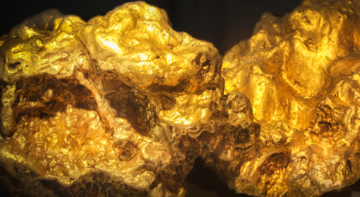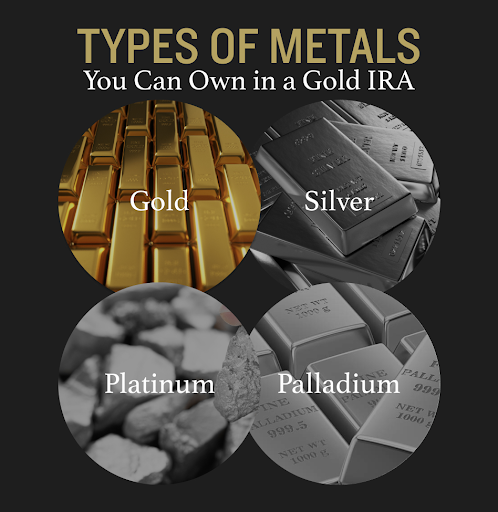- Home
- Gold IRA Investment
- Gold IRA Beginner's Guide
What is a Gold IRA?

Table of Contents
Table of Contents
What is a Gold IRA?
A Gold IRA is a type of individual retirement account (IRA) that allows you to own physical gold inside of an IRA. Often referred to as a precious metals IRA, it is much like a conventional IRA, but is self-directed and gives you the option of owning physical assets, as well as more traditional paper investment products.
Considering the current political and economic climate, investors are actively seeking ways to safeguard and maintain their financial resources. Investors are turning to physical gold to anchor their portfolios.
A Gold IRA offers a unique opportunity to diversify your investment portfolio by allowing you to own both paper instruments and tangible assets, like gold bars and coins. This means that you can benefit from the stability and liquidity of traditional investments while also having the added security of owning physical assets with inherent value. In other words, with a Gold IRA, you can have the best of both worlds.
What are the benefits of a Gold IRA?
There are many benefits to opening a gold IRA account. A gold IRA can:
- Help diversify your portfolio
- Provide a hedge against inflation
- Add security and ensure your wealth
Diversify your portfolio
Remember the saying, “Don’t put all of your eggs in one basket?” That’s especially the case with investing.
The stock market is divided into 11 sectors:
- Energy
- Materials
- Industrials
- Utilities
- Healthcare
- Financials
- Consumer discretionary
- Consumer staples
- Information technology
- Communication services
- Real estate
While conventional wisdom may dictate owning stock from each sector as a way to balance and diversify a portfolio, this tactic leaves the investor with only one asset class—stocks.
A typical recession or market correction may adversely affect many, if not all, of the sectors of the entire stock market and, therefore, adversely affect the value of your stock portfolio.
Physical gold in an IRA is an entirely different asset class and is not married to the turbulence and fluctuations of the stock market. Gold is true diversification.
Hedge against inflation
As we have seen in real time, gas prices are near all-time highs, and the costs of goods and services have exploded. All the while, wage increases have stayed stagnated, and companies are tightening their belts and eliminating jobs.
Wise investors often turn to physical gold in times like these. Gold is widely recognized as a reliable investment option during times of economic uncertainty. It is often referred to as a safe-haven asset. Investing in gold can protect protection against inflationary pressures, as it has historically demonstrated significant price increases during such periods. Additionally, gold can serve as a means to preserve the value of your currency.
When goods get more expensive, gold typically does too. But, unlike that expensive 80-inch television, gold tends to hold its value, and allows you to preserve your investment dollars.
Add security to help ensure your wealth
Physical gold is tangible. You can hold it in your hand, put it under your pillow at night, or lock it securely in your safe.
The financial crisis of 2008 showed us that companies that have seemingly been around forever can vanish in a flash. Investment firms went out of business. The government had to bail out the automakers and the insurance industry. Tax dollars had to be lent out to private firms that were no longer soluble.
Gold has never failed. In fact, from 2008 to 2012, gold nearly doubled in value. It has historically stood the test of time.
Types of Gold IRAs
No matter your investment style, your tax status preference, or your employment status, there is a Gold IRA that fits.
There are three types of Gold IRAs:
- Traditional Gold IRA
- Roth Gold IRA
- SEP Gold IRA
Converting a standard IRA to a Gold IRA is tax- and penalty-free, and you will not lose value just because you want to add precious metals to your portfolio.
Traditional
A traditional Gold IRA account allows you to contribute pre-tax dollars every year up to $6,500 for those under age 50, and up to $7,500 for those age 50 and up. Depending on your situation, that contribution may be tax deductible.
Your investments grow on a tax-deferred basis, meaning they are not taxable unless you withdraw the funds early or begin taking unpenalized withdrawals at the allowed age of 59 1⁄2. At age 73, you must take withdrawals called required minimum distributions (RMDs) and pay income tax.
Traditional IRAs may be a good option for you if you anticipate being in the same or lower tax bracket in the future.
Roth
A Roth Gold IRA allows you to contribute after-tax dollars. You will not see an immediate year tax benefit, but a Roth IRA grows tax-free. At the age of 59 ½, if your Roth has been established for five years and you choose to take a distribution, that distribution is not taxed.
Unlike a traditional Gold IRA, a Roth IRA has no RMD requirement. You are never forced to take a required distribution, as mandated with the traditional IRA, because you have already paid taxes on the funds used to establish the account. There are, however, income limitations when opening a Roth IRA, as not all will be eligible for this type of IRA.
If qualification is met, a Roth is an excellent option for those who anticipate being in a higher tax bracket in the future.
SEP IRA
A Simplified Employee Pension IRA is a retirement plan for the self-employed or the small business owner. In essence, you fund your own retirement plan and can make tax-deductible contributions up to the allowable maximum.
The SEP-IRA allows a much higher level of contribution, and much like the Traditional Gold IRA, SEP investments grow on a tax-deferred basis, allow for penalty-free withdrawals starting at 59 ½ years old, and require RMD withdrawals at age 73.
Please consult your tax advisor on what plan is right for you.
What kind of metals can I have in a Gold IRA?

IRA-eligible gold describes the different types of gold coins and bars you can use to fund your gold IRA. That said, you’re not limited to just gold. You can also fund your IRA with silver, platinum, and palladium.
The above metals must meet specific purity, quality, condition, and weight requirements.
What are the Risks of a Gold IRA?
Even though Gold IRAs are a fantastic investment opportunity, they’re not without risk. Before you embark on purchasing gold as a retirement vehicle, consider the following:
Market volatility
Like any investment, gold’s value can fluctuate significantly. Many factors influence gold prices, including macroeconomic conditions, geopolitical events, and investor sentiment. These fluctuations can impact the overall value of your gold IRA.
Storage and security
Physical gold requires secure storage to protect its value. Storing gold with a reputable depository is a requirement of a gold IRA, but it does come with associated costs. Do your research and choose a trusted depository with established security measures.
Liquidity challenges
While gold is a liquid asset, converting physical gold to cash during financial need might be challenging, but not impossible. Selling gold coins or bars may entail additional costs or delays, especially in difficult market conditions or low buyer demand.
Legal and regulatory changes
Government regulations surrounding IRAs and precious metals can change over time. To avoid unintended consequences or penalties:
- Speak with a financial or tax advisor
- Keep up with any changes in tax law, reporting requirements, or IRA rules
How to open a Gold IRA

At this point, you’re probably asking, “How does a gold IRA work?”
Whether you open a brand-new account or roll over an existing one, opening a Gold IRA is simple. Your account representative will walk you through the application. This process typically takes 15 minutes. They will answer any questions along the way, and most find it painless and time efficient.
1. Understand Gold IRA rules
Owning gold in your IRA is one of the safest ways to own physical precious metals. The IRS has strict guidelines on the origin, quality, and purity of your gold.
For example, coins must be at least 99.5% pure, be uncirculated, and from approved government mints. Gold bars on the other hand, must meet the same level of purity, and can only come from approved manufacturers, all of whom are traded on the COMEX exchange.
2. Select a custodian
Just like the IRS has strict guidelines for the kind of gold that is allowed in your IRA, it also maintains strict standards for who is allowed to be the custodian of your account.
Your IRA custodian is the host of your account. The custodian’s name is typically on your statements, and they complete and send out all of the paperwork. As you can imagine, there are mountains of auditing and reporting reports as well as regulatory requirements. Your custodian handles all of that, so that you don’t have to.
Your account’s custodian is like a very hard-working silent partner. It is there when you need it, but otherwise, it is quietly working hard for you in the background.
Gold IRA firms like Advantage Gold typically have an IRS-approved custodial partner.
3. Purchase precious metals
You’ve decided to own physical gold, chosen your favorite Gold IRA firm, and have a great rapport with your account executive.
The next thing you need to do is fund your Gold IRA. You can do this by either rolling over an existing IRA or 401K, or by opening a new IRA and depositing your desired contribution. Both methods are simple and straightforward.
Once your account is funded, discuss the options of eligible gold bars and coins with your executive. They should be able to walk you through all of the available options expertly, and offer suggestions to suit your needs. The final decision on exactly what eligible gold will be held in your Gold IRA is yours and yours alone.
Learn more about starting a Gold IRA
Physical gold ownership inside of an IRA is easy, safe, and offers options that differ from paper asset ownership. For true protection, diversification, and potential growth, gold is sure to stand the test of time.
To get started, contact us and one of our Advantage Gold specialists will answer any questions and quickly walk you through the process.
We’re happy to help.
What are the Benefits of Gold IRA?
A Gold IRA is a type of individual retirement account (IRA) that allows you to own physical gold inside of an IRA. Often referred to as a precious metals IRA, it is much like a conventional IRA, but is self-directed and gives you the option of owning physical assets, as well as more traditional paper investment products.
Considering the current political and economic climate, investors are actively seeking ways to safeguard and maintain their financial resources. Investors are turning to physical gold to anchor their portfolios.
A Gold IRA offers a unique opportunity to diversify your investment portfolio by allowing you to own both paper instruments and tangible assets, like gold bars and coins. This means that you can benefit from the stability and liquidity of traditional investments while also having the added security of owning physical assets with inherent value. In other words, with a Gold IRA, you can have the best of both worlds.
The Power of Precious Metals In Your IRA
Adding gold and silver to your IRA can reduce overall portfolio risk. Gold offers stability in turbulent times, protecting against inflation, market volatility, and economic downturn. Explore your options today!


Get your FREE Gold Investment Guide Today!
